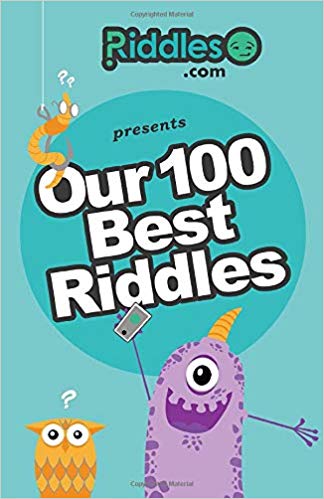Enter a keyword into the search box. The riddle search will check to see if the word is in the Title, Riddle, or Answer and return results if they exist.
"Empty" Riddles - Final 8 of 38
Riddle:
If you were to put a coin into an empty bottle and then insert a cork into the neck, how could you remove the coin without taking out the cork or breaking the bottle?
Answer: Push the cork into the bottle and shake the coin out!
Riddle:
What is it that is full all day and empty at night?
Answer: Shoes.
Riddle:
I have three envelopes, into one of them I put a $20 note. I lay the envelopes out on a table in front of me and allow you to pick one envelope. You hold but do not open this envelope. I then take one of the envelopes from the table, demonstrate to you that it was empty, screw it up and throw it away. The question is would you rather stick with the envelope you have selected or exchange it for the one on the table. Why? What would be the expected value to you of the exchange?
Answer: The answer might seem a little counter intuitive at first but we'll see... The short answer is that it is in your advantage to exchange. But why? Well initially there was a 1/3 chance that you were holding the envelope with the note in it and a 2/3 chance that the note was on the table. This is still the case after one of the envelopes on the table has been removed, there is still a 1/3 chance that you have the note and a 2/3 chance of it being on the table. If this is confusing then it may help to think that the questioner knows which envelope the $20 note is in, though in practice it doesn't actually matter. The questioner would always be able to demonstrate that the note was not in one of the envelopes on the table regardless of where the note was, so the fact that he was able to do this changes nothing. Consider a different example.... Say there are a 1000 envelopes on the table, 1 with a note inside. You pick 1 envelope, the chance that this has the note in it is clearly 1/1000, where as the chance that it is still on the table is 999/1000. Odds are its on the table. Now the questioner could, assuming he can remember where the note is demonstrate to you that the note is not in 998 of the envelopes on the table. In this case nothing would have happened to change the fact that there is only a 1/1000 chance of you having the note. That is why you exchange. What is the value of the exchange? Simply before the exchange you have 1/3 of $20 and afterwards you will have 2/3 of $20, ie the advantage to you is about $6.66
Riddle:
In the back yard, there is a hollow stump, that contains six ears of corn. If a healthy squirrel carries out only three ears each day, how many days will it take to empty the stump?
Answer: Six. Each day the squirrel will carry out the two ears on his head plus one ear of corn.
Riddle:
Julie is going on an extended trip for three weeks. She lives in a remote area where there are frequent electrical power outages which can last up to three or four days. Julie has quite a bit of food in her freezer which would go bad if it thawed and then re-froze. She does have digital clock and a VCR which would flash 12:00 if the power went out. Unfortunately the clock and VCR flash even if the power only goes out for a few seconds. What can Julie do so that when she returns home she will be able to determine whether the power was out long enough to thaw her food? Asking a neighbor whether the power was out, isn't a reliable option because the nearest house is half a mile away, and one house may have power, while another house may have no power. She won?t be able to have a neighbor check on her house every day, and has no one to house sit.
Answer: One thing Julie could do is freeze a tray of ice-cubes, and turn the tray of ice upside down in her freezer. When she comes home, she should check the tray. If the ice cubes are still in the tray, the food is safe to eat. If the trays are empty, it's time to clean out the freezer. She will have to make a judgment call if the ice-cubes are only slightly thawed.
Riddle:
A mother has three sick children. She has a 24-ounce bottle of medicine and needs to give each child eight ounces of the medicine. She is unable to get to the store and has only three clean containers, which measure 5, 11 and 13 ounces. The electricity is out and she has no way of heating water to wash the containers and doesn't want to spread germs. How can she divide the medicine to give each child an equal portion without having any two children drink from the same container?
Answer: Fill the 5 oz. and 11 oz. Containers from the 24 oz. container. This leaves 8 oz. in the 24 oz. bottle. Next empty the 11 oz. bottle by pouring the contents into the 13 oz. bottle. Fill the 13 oz. bottle from the 5 oz. container (with 2 oz.) and put the remaining 3 oz. in the 11 oz. bottle. This leaves the 5 oz. container empty. Now pour 5 oz. from the 13 oz. bottle into the 5 oz. bottle leaving 8 oz. in the 13 oz. bottle. Finally pour the 5 oz. bottle contents into the 11 oz. bottle giving 8 oz. in this container.
Riddle:
You have two container, a 5 gallon and a 3 gallon container. How do you measure out 4 gallons?
Answer: Fill up the 3 gallon container and pour the 3 gallons into the 5 gallon container.Then, fill the 3 gallon container back up, and pour it into the 5 gallon container.The 3 gallon container will have 1 gallon left. Empty the 5 gallon container.Pour the remining 1 gallon into the 5 gallon container.Then fill the 3 gallon container back up and pour it into the 5 gallon container.Thus, you have 4 gallons.
Riddle:
Five baby boomer couples each have one child. Each child is a different age than any of the other children. Each child has a favorite toy which is different from any of the other children's favorite toys. Each family eats at only one fast food restaurant. No two women have the same name and no two men have the same name. The children's names are not known. The child who plays with trains is the youngest. Bill's child plays with a GI Joe. Julie's child likes Pokeman. Mike's family eats at Taco Bell. The family of the 4 year old likes Kentucky Fried Chicken. The oldest child is four years older than Marie's child. The child who plays with Barbie is 8 years old. The child with the age is in the middle, has a mother named Marie. The child in the family that eats at McDonalds has a two year age difference with Larry's child. Carol is the mother in the family that eats at Dairy Queen. The child that plays Nintendo likes Burger King. Steve's child is two years apart in age from the child of the family that eats at Kentucky Fried Chicken. The child that plays with trains is two years apart from the 6 year old. The child that eats at McDonalds is two years older or younger than Regina's child. Lisa's child is 10. Who is married to George?
Answer: Lisa is married to George, and their 10 year old plays with Nintendo. They like to eat at Burger King. The associations are: Child age 4, mother Regina, Father Larry, trains, KFC Child age 6, mother Julie, Father Steve, Pokeman, McDonalds Child age 8, mother Marie, Father Mike, Barbie, Taco Bell Child age 10, mother Lisa, Father George, Nintendo, Burger King Child age 12, mother Carol, Father Bill, GI Joe, Dairy Queen To solve, draw a grid with five rows and five columns. Across the top, above the columns, write Age, Mother, Father, Toy and Food. Figure out the known ages and write them in order in the first column. One child's age is unknown at first. However, once the youngest child is discovered (the one who plays with trains) it is then known that the oldest child is the child with the unknown age. Through additional clues, it is possible to determine that the oldest child is age 12. Take the clue, Lisa?s child is 10. In the mother column corresponding to the age 10, you would write LISA (Maybe circle it, because it is the correct answer.) In the mother column for every other age, write "not Lisa". Do this for each clue. If you know the answer because of a clue, write it in the appropriate column, and then be sure to write "not such and such" in all the other rows for that clue. For example, "The youngest child plays with trains", would result in "not trains" for any child you can tell isn?t the youngest, but you can?t write "trains" for any child, because you don?t know which child is the youngest at first. Eventually, you may find that "mother not Marie" is on every line except one, and then you would know that Marie is the mother on the empty line.

